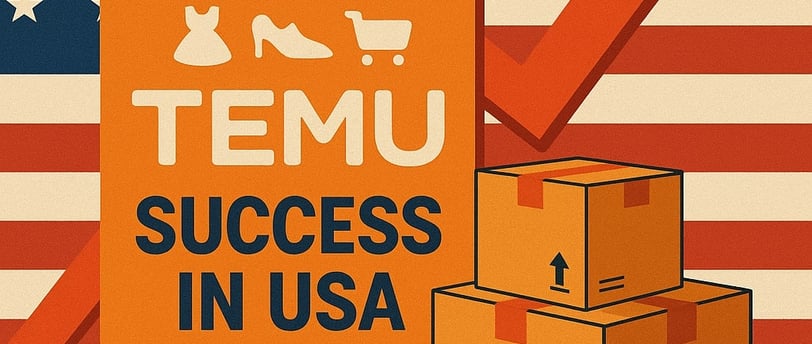Temu in America: The Billion-Dollar Bargain That Changed How We Shop
Temu, the Chinese-owned e-commerce app, exploded onto the U.S. retail scene in 2024 with ultra-low prices, aggressive marketing, and a disruptive supply chain model—racking up $70.8 billion in global sales and capturing 17% of the American market. This article explores how Temu reshaped online shopping and challenged the dominance of retail giants like Amazon.
Brishabh Shukla
5/20/20253 min read


Temu, the discount e-commerce platform owned by Chinese tech giant PDD Holdings, has taken the U.S. retail landscape by storm. Since its American debut in September 2022, Temu has rewritten the playbook for digital commerce in the West—disrupting traditional pricing models, redefining logistics, and captivating consumers with its “shop like a billionaire” tagline. By 2024, the platform had become one of the most dominant players in U.S. e-commerce, cementing its place as a global powerhouse.
2024 Revenue and Market Penetration
In 2024, Temu global gross merchandise volume (GMV) skyrocketed to approximately $70.8 billion, up nearly 300% from $18 billion the previous year. Although Temu does not publicly release its regional financials, estimates suggest that the U.S. accounted for a substantial portion of this GMV—driven by its aggressive expansion and marketing in the American market.
Temu now controls around 17% of the U.S. e-commerce market as of April 2024, positioning it as a legitimate rival to Amazon, Walmart, and eBay. It surpassed longtime challengers like Wish and Shein in both downloads and user engagement, with its mobile app becoming the most downloaded shopping app in the United States.
Key Factors Behind Temu U.S. Success
1. Relentless Focus on Low Prices
Temu business model hinges on connecting consumers directly with Chinese manufacturers through a streamlined supply chain. This Direct-from-Manufacturer (DFM) approach slashes costs typically accrued from intermediaries. Shoppers are presented with ultra-low prices on everything from electronics to clothing to kitchenware—often at a fraction of what they would pay on Amazon or Walmart.
2. Aggressive Marketing and Brand Positioning
Temu spent lavishly on marketing in 2023 and 2024, including two high-profile Super Bowl ad campaigns, which instantly elevated its brand recognition. The ads highlighted the platform’s affordability and encouraged users to “shop like a billionaire,” reinforcing its appeal to price-sensitive consumers amid economic uncertainty and inflationary pressure.
3. Gamified User Experience
Beyond price, Temu leverages a highly engaging user experience. Features like flash deals, spinning wheels, and referral bonuses gamify shopping and keep users glued to the app. In 2024, users averaged 18 minutes per day on the Temu app—more than double the time spent on traditional e-commerce platforms.
4. Massive Product Variety and Fast Scaling
Temu parent company, PDD Holdings, uses AI and big data to analyze customer preferences, which enables rapid product scaling and personalization. The platform offers millions of SKUs across nearly every product category, constantly updating inventory to stay ahead of consumer demand trends.
Challenges and Trade Headwinds
Temu rapid growth hasn’t come without obstacles. In 2025, the U.S. government—under growing bipartisan pressure to curb Chinese imports—closed a key trade loophole known as de minimis, which allowed Temu and similar platforms to avoid duties on packages under $800.
As a result, Temu began shifting more inventory to U.S.-based warehouses and promoted “local” products more heavily in its app. It also resumed direct shipping from China in select cases where pricing remained competitive despite tariffs.
The shift tested Temu core value proposition: Could it maintain ultra-low prices while adapting to new regulations? So far, the answer seems to be yes—at least in part—through logistics optimization, data-driven pricing, and lean operational models.
The Bigger Picture: A Global Retail Transformation
Temu is more than a fast-growing app; it’s a case study in how supply chains, consumer behavior, and international trade are evolving. The platform’s success marks a broader trend of reverse globalization, where Chinese companies are no longer just manufacturers but direct competitors on foreign soil.
Temu model reflects the next phase of retail: algorithmically driven, vertically integrated, and ruthlessly efficient. While critics raise valid concerns over product quality, labor standards, and market saturation, Temu U.S. rise remains one of the most impressive retail stories in recent memory.
Looking Ahead
Whether Temu can sustain its momentum under mounting regulatory and competitive pressure remains to be seen. But with tens of millions of loyal users, a proven pricing strategy, and a war chest from PDD Holdings, Temu has already changed how Americans shop—and it’s not slowing down anytime soon.
If Amazon is the digital department store of the past two decades, Temu is shaping up to be the disruptor of the next.
